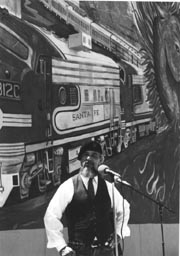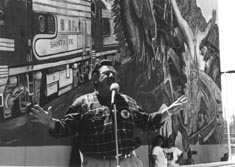 |
|
|
Volume V |
May/June 2000 |
Number V |
|
|
Los Ancianos y AmigosANNOUNCEMENTSFinding Funds for Acequia Rehabilitation Projects a Long and Arduous Process Editorial: An Ounce of Prevention By Mark Schiller |
Santa Barbara Rehabilitation Project Completes Prescribed Burn By Mark Schiller Editorial: Whose Water is it Anyway? By Kay Matthews Cañada Maria Piñon/Juniper Restoration Project By Max Córdova, Jr. and Nova Romero of the Truchas Montaña Youth Team The Million Men and Women La Nueva Raza Peace March in Albuquerque |
|
Santa Barbara Rehabilitation Project Completes Prescribed BurnBy Mark SchillerThe fire crew at the Camino Real Ranger District was scrupulous in following prescribed burn guidelines and successfully burned approximately 100 acres on Santa Barbara's Bear Mountain. Fire Management Officer Manuel Romero told La Jicarita that his crew waited for a good window of opportunity and carefully prepared the area before the burn, which took place April 27. The area where the burn occurred was first thinned last summer by community members hauling personal-use firewood and thinning crews from the ranger district and the community. The Forest Service monitored the remaining slash to determine when it was dry enough to carry a fire. Romero and members of his staff then determined a prescription which included a maximum temperature and wind velocity and a minimum relative humidity. In this case they determined they would not burn if the temperature exceeded 80 degrees, the wind exceeded 15 miles per hour, and the relative humidity wasbelow 12%. About a week before the fire, crew members burned what they call a "black line" around the perimeter of the burn area. The black line, which in this case was approximately 132 feet wide, acts as a buffer to ensure that the fire stays within the prescribed area. With all of this in place, the crew then waited for a weather forecast which met prescription guidelines. Having determined that April 27 met all guidelines, the 6 member crew and tanker truck got an early start. Romero notified community fire chief Randy Sahd of the burn and continued to monitor weather conditions throughout the morning. At 11:30 a.m., when the temperature reached 78 degrees and the relative humidity dipped to 15%, he shut down the fire and didn't resume until 4:30 that afternoon when conditions improved By 10:00 p.m. the fire was completed. Romero and Steven Miranda, the Range Management Officer in charge of the Santa Barbara Rehabilitation Project, explained that thinning and prescribed burning not only reduce the threat of catastrophic fire but improve understory and overstory conditions. Timber Management Officer, Carol Holland, explained that there's a real art to managing a successful prescribed burn: "You need a little wind to carrythe fire and make sure it moves fast enough so that the leave trees are not damaged. But you don't want so much that the fire has any chance to jump the prescription boundaries." Everyone at the district office agreed that the consumption of this fire was good. They'll be monitoring the area to see how the leave trees fared and when the rains come will be reseeding the area with a mixture of fescue, brome, mountain mahogany, Kentucky bluegrass, blue gramma, and timothy. The fire crew hopes to burn 200 additional acres which have already been thinned when conditions permit in the fall. Editorial: Whose Water is it Anyway?By Kay MatthewsA month ago the Journal North ran opposing opinion pieces on its Op-Ed page talking about the recent injunction filed by a coalition of environmentalists (Defenders of Wildlife, National Audubon Society, Sierra Club, Forest Guardians, Southwest Environmental Center) to force federal agencies to keep water in the Rio Grande from San Acacia down to Elephant Butte. In his piece, Bill Hume, Editorial Page Editor, perceptively analyzed the issue as one that will pit the feds against state agencies that currently administer water rights: If the Endangered Species Act trumps all law governing allocation of water in the Rio Grande Basin, then the priority right system that governs human use is rendered moot. Lettie Belin, attorney for the environmentalists, claims that the lawsuit is a straightforward attempt to achieve what most "New Mexicans want to see in the Rio Grande," i.e. flowing water and a healthy bosque. Would that it were so simple. Hume was able to see past the typical instream flow rhetoric to the potential legal impacts. This issue is already coming to a head in Colorado, where a water rights holder is threatening to file suit if the White River National Forest Plan (currently in the draft stage) implements a federal water right to maintain instream flow within the forest. As is the situation in New Mexico, all Colorado water is already appropriated, and any federal attempt to provide a right of flow would abrogate state law and constitute a "taking". But there are other potential impacts that need to be addressed as well. The environmentalists direct their legal actions at the bad boy Middle Rio Grande Conservancy District (MRGCD), but what they continually fail to acknowledge is the connection between the conservancy district and the acequias. (Interestingly enough, they left the Native American Pueblos out of the injunction. Is it politically correct to respect Native American sovereignty but not that of the Indo-Hispano community?) While the acequia community doesn't necessarily see eye to eye with the MRGCD in terms of sustainable water use, it does recognize that they both share many of the same interests in water policy. Acequia advocates have said over and over again in public meetings, in roundtable discussions with these environmentalists, in newspaper articles, and at the state legislature, that defining instream flow as a federal water right or as a beneficial use is directly tied to the commodification of water rights that have been traditionally defined as community rights tied to their lands of origin. Once state water law is subordinated and water becomes a free market commodity sought after by developers, urban areas, or the federal government, the most vulnerable water rights will be acequia water rights. Parciantes are already being marginalized by not being able to actually use their "appropriative rights". Historically, of course, water was shared as a community resource with less regard to "appropriative" or "priority" rights, concepts that were formalized when New Mexico became a state. But even with the imposition of priority and private property concepts, acequia parciantes have continued to share their village water, particularly in times of drought. Now, as more and more northern New Mexico parciantes become involved in organic and specialty farming, they face the threat of losing these rights to hungry cities and greedy developers. This, of course, would result in the most damaging cumulative impact of all: the loss of agricultural lands to development. Acequia advocates also have been pointing out to anyone who will listen that the loss of open space is the single biggest threat to wildlife, habitat, water, and culture. Irrigation has created a riparian landscape that dammed and manipulated rivers cannot provide. The human community they support is essential to the culture and economy of the state. (What do tourists come to el norte to experience? McDonald's?) Do the environmentalists really believe their lawsuits are simple answers to complex issues, like Lettie Belin's op-ed piece seems to be saying, or does their vision of el norte exclude the "inhabited wilderness" of traditional rural communities, replaced by "untrammeled wilderness" and unfettered industrial recreation? Our state engineer, Tom Turney, seems to favor the latter vision. In a recently released statement Turney said that his office plans to take a more active role in management of the Rio Grande, and that one part of his program will be to focus on markets for water, making it easier to transfer water rights from agricultural to municipal use: "We need to be able to move water rights around." The question of whether keeping water in the Rio Grande between San Acacia and Elephant Butte will save the silvery minnow is debatable, as is the question of how much water the MRGCD diverts from the river and how much is returned. But as the debates rage on, a partnership between the University of New Mexico and the city of Albuquerque is addressing the immediate need to save the minnow with a rescue, spawning, and release program. Bill Hume suggests in his editorial that we need to explore other options for releasing water into the Rio Grande in emergency situations without imposing the Endangered Species Act and opening the door to what would become a battle between the state and feds over control of our community waters. What we really need is some vision that extends beyond immediate needs and simplistic agendas. To apply what historian Richard White says about the Columbia River to the Rio Grande: "If the conversation is not about fish and justice, about . . . ways of life, about production and nature, about beauty as well as efficiency, and about how there things are inseparable in our own tangled lives, then we have not come to terms with our history on this river." Cañada Maria Piñon/Juniper Restoration ProjectBy Max Córdova, Jr. and Nova Romero of the Truchas Montaña Youth TeamThe Carson National Forest has several projects planned for this year to meet the needs of the community for fuelwood and at the same time do restoration work. On April 30, 2000 the Truchas Montaña Youth Team met with Carson National Forest Timber Staff Officer Henry Lopez to discuss and review the Cañada Maria Piñon/Juniper Restoration Project. The project is located near the Chamisal transfer station and recycling center. The Forest Service will set up contract stewardship blocks for the work needed in the unit. The Truchas Montaña Youth Team will assist the Forest Service in marking the plots and identifying and photographing existing conditions. The youth will document the work being done and will assist in implementation and monitoring.The Forest Service will train the youth in using a compass and the GPS (Global Positioning Satellite) system, and will teach them to lay out the stewardship blocks. The first task of the youth team is to set photo points on the unit to be used to monitor present and future conditions. La Montaña de Truchas has helped the youth team by purchasing a video camera, a digital camera, and other photographic equipment to document the work the Forest Service and the community are doing. The youth team will work with the Forest Service for the next few months on monitoring and other needed research on the Cañada Maria Piñon/Juniper Restoration Project. The youth team will also continue to work with the Forest Service to establish more fuelwood areas. The Million Men and Women La Nueva Raza Peace March in AlbuquerqueTop to bottom, State Senator Manny Aragon; march organizer Felipe Córdova; Donna Garcia Price, mother of Eric Sanchez

A Thank You Message to our SupportersNow in our 5th year of publication, La Jicarita News has been largely dependent upon charitable foundations to underwrite the cost of the paper: McCune Charitable Foundation; New Mexico Community Foundation; Santa Fe Community Foundation; Maki Foundation; and Bread for the Journey, among others. The McCune Charitable Foundation in Santa Fe has been our most loyal supporter, and we want to take this opportunity to thank Owen Lopez, Fran Sowers, and their board of directors for this support. With 2000 monies we will be able to expand the bulk mailing to the communities of Dixon and Embudo (we already send La Jicarita to many individuals in these communities who have subscribed). We will continue to pay contributors to our Puntos de Vista column, highlight individuals and organizations involved in economic development enterprises, and interview ancianos from our communities in our Oral History column. We will also initiate a feature that will explore the histories of land grants in our area.We are asking those of you who are already on our subscription list to please send in your $5.00 (you can't beat that deal) for the year 2000, if you have not already done so (you may now do this via our website at www.lajicarita.org, see page 2). And for those of you who would like to make a larger contribution to the paper, we ask that you make a donor contribution, which is tax deductible, in any amount you can. The paper has purposely declined to run advertisements to raise money, preferring to put our energy and space into covering issues of import to el norte. And because of our very regionalized focus, we will never be able to support our work from subscriptions alone. But with your continued help and the support of foundations, we will be able to partner with those who tirelessly work to maintain and protect el norte's rural communities and resources. |
Home | Current Issue | Subscribe | About Us | Environmental Justice | Links | Archive | Index
Copyright 1996-2000 La Jicarita Box 6 El Valle Route, Chamisal, New Mexico 87521.







